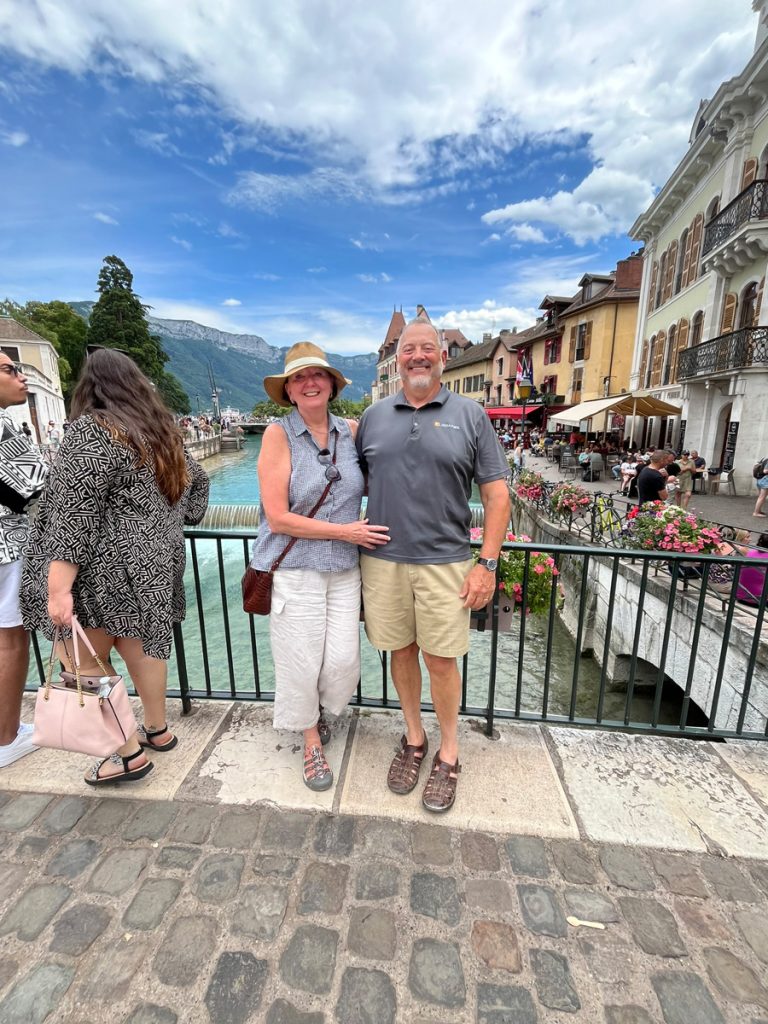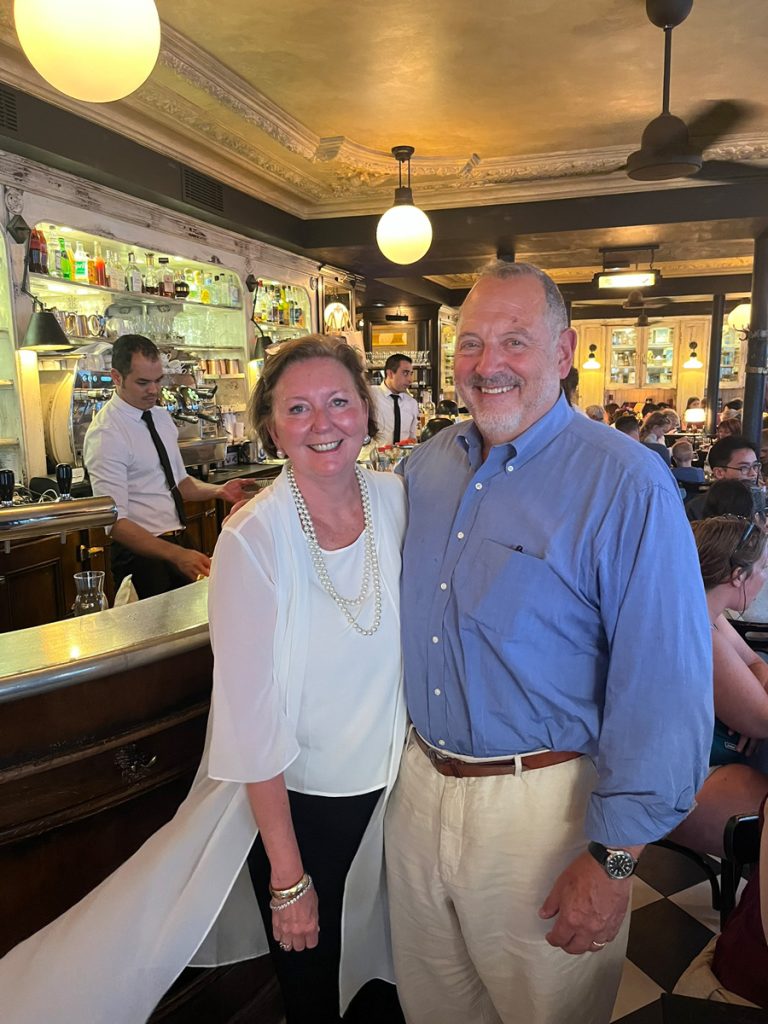From Paris to Annecy and Back—Enjoying the City of Light and the Venice of the Alps in one vacation
We flew from JFK Airport to Charles De Gaulle Airport in Paris and settled into our room at the Hilton Paris Opera, an ornate building built in 1889 to welcome visitors to the World’s Fair—the Exposition Universelle—held in Paris that year. The Hilton, recently renovated and restored to old glory, features an elegant bar in the soaring beaux-arts atrium.
We hit the streets right away and visited the Musée Rodin (Rodin Museum) nearby. Later, we dined at Benoit on Rue Saint-Martin. This 112-year-old Michelin-starred restaurant is named for its founder, Benoit Matray, a butcher. He insisted that all customers are warmly welcomed as a friend, a tradition that holds today.
Day two began at the Musée de Cluny, the national museum of the Middle Ages, housing an astounding collection of religious art and artifacts, weapons of medieval warfare, and tapestry. Being in the lively Latin Quarter, we had our pick of sidewalk cafes for lunch and a glass of Sancerre before heading to Le Musée de l’Orangerie.
While it is famous for Monet’s Water Lilies murals, the Orangerie also features a rich and varied collection of impressionist and post-impressionist art, with works by Picasso, Modigliani, Cézanne, Renoir, and others. We bought a Paris Museum Pass online in advance, which allowed us to skip the ticket line at almost every museum.

Dinner that evening was at Les Antiquaires (the Antique Dealers) nested among a busy neighborhood of bars and restaurants. That evening, France was playing Spain in the Euro Cup. When France scored the first goal, bars with TV screens erupted with jubilant cheers. It was fun to stroll the streets and soak in the national elation. (No need to mention Spain’s subsequent two goals.)
Walking in Paris is always lovely, but streets at intersections are not always clearly marked. We often took advantage of Google Maps Live view to help us navigate. We pointed the phone camera at surrounding buildings and on-screen arrows directed us. When it was too far for a walk, the Metro system was a super-easy way to get around even if you do not speak French. (Pro Tip: Buy a multi-ride pass, not individual passes.) For short hops, taxis were plentiful and reasonable, but be ready to pay with Euros. Some taxis don’t take credit cards. Uber works just as well, although it is more expensive than a taxi.
A Weekend at Le Lac d’Annecy
From the Gare du Nord station, we took a four-hour train heading southeast to Annecy. First class tickets put us in a wide, comfortable seat on the top level, all the better for watching the pastoral French countryside roll by. As we passed a farm, a sweet young boy on our train exclaimed, “Papa! Regardes! Un tracteur!”
We were fortunate to have been invited to Annecy by a childhood friend, Randy Smith, a New Orleans lawyer who has for 10 years or so rented a 12-bedroom chalet-style house on the shore of Lake Annecy in a village called Sévrier. Each July, Randy, his wife, Diane, and their daughter Maggie, a sophomore cross-country runner at Wesleyan, invite an eclectic group of friends for a family-style vacation that includes riding bikes around the lake, hiking, swimming, sailing, paddle-boarding, and enjoying dinners with as many as 22, sometimes in the cool evening air on tables outside.
The house, built in 1928 by a Lyons silk merchant named Paul Roche, is now owned by his granddaughters, who rent it every year to Randy in part because he embraces and celebrates the 96-year traditions of their family gathering place.
Each morning an early riser rode his bike to a local boulangerie to provide us with baguettes, croissants, pain au chocolates, and assorted quiches. The group prepared meals using local poultry, beef, vegetables, and fruit—some of which were harvested that same day.

One day the group hiked up the Parmelan, a 6,010-foot peak overlooking Annecy. The climb included steep switchbacks up a limestone face, with cables attached to the rock. “Only 10 meters to the top,” said a descending hiker to me, as I held on to a cable for dear life. He meant to the top of the rockface, and it was more like 20, but he was trying to be nice. From there it was another 30 minutes to lunch at the Camille Dunant Refuge, named after the founder of the Annecy Tourist Office in 1895.
The mountaintop plateau offered a clear view of Mont Blanc, the tallest Alp, on one side and the city of Annecy and the tip of the lake on the other. Descending, we heard the bells of a flock of sheep and saw them ascending from one grassy hillside field to a higher one, Heidi style.
Annecy, an hour south of Geneva, Switzerland, and an hour and a half east of Lyons, was a Roman village in the first century. In the Middle Ages, its château was a stopover on the route to Jerusalem for crusaders.
One day we walked several miles on a lakeside trail into Annecy. The pedestrian trail runs parallel to a busy biking trail that circumnavigates the lake. It takes an average biker about three hours to do the circuit. Some of the serious French bikers look like they can do it in an hour.
We walked into Old Annecy along the Thiou, the river that flows out of the lake and into the winding canals that give Annecy its moniker as the Venice of the Alps. Ferries leave regularly to take tourists to the scenic villages around the lake. If you get off at Talloires—a picturesque village nestled at the foot of the sharp white-rock ridges of the Dents de Lanfon (the teeth of Lanfon)— you can dine at the five-star lakeside restaurant Le Père Bise (Old Man Bise, a tribute to the founder.)
There are plenty of restaurants and ice cream shops scattered throughout Old Annecy, which simply couldn’t be more charming. Narrow cobbled streets led us past pastel-colored buildings and up to the Château d’Annecy, which now houses an archeological and an art museum. The circular stone staircases are narrow enough that you understand how they aided in defending against invaders in the day. In the archeological museum, we learned that Neolithic fishermen lived over the water in houses supported by wood pilings. Researchers have found remnants pilings still sticking up from the lake bottom.
It was fun to be Annecy on Bastille Day; the town was alive with families and fireworks, which we watched that evening from a lakeside restaurant, Le Pêcheur.

Back to Paris
We returned to Paris and walked along the Seine, past Notre Dame and the scaffolding of its ongoing repairs after its devastating 2019 fire. We had a wonderful dinner at La Fontaine De Mars. This bistro-brasserie is an institution that has preserved its original moldings, red leather benches and a traditional menu of poulet roti and cassoulet.
The next day, we did some shopping and then went for a stunning haute cuisine lunch at La Tour D’Argent (the Silver Tower), a famous restaurant dating back to 1582. In 1890, owner Frédéric Delair began the tradition of presenting a numbered certificate to each person who ordered the restaurant’s signature dish, pressed duck. Serial number 112,151 went to Franklin D. Roosevelt, No. 203,728 to Marlene Dietrich, and No. 253,652 to Charlie Chaplin. Our canard was No. 1,187,432.
Our last day was a lovely morning on the Rue du Faubourg, one of Paris’s chicest streets. Running parallel to the Champs-Elysées, it’s an extension of Rue Saint-Honoré. We admired the sumptuous 18th- and 19th-century private mansions; the Elysée Palace, headquarters of the Presidency of the French Republic, the Ministry of the Interior, the residence of the American Ambassador and the British Embassy.
Of course, Rue du Faubourg Saint-Honoré includes some of the most exquisite houses of couture fashion as well as the trendiest boutiques from Hermès and Lanvin to Colette, and we did our part to support the French economy. If you do plan to shop, remember to bring your passport, so you can have the sales tax refund forms completed at the store.
We agreed that combining visits to Paris with time in a lakeside village enabled us to soak in the eternal beauty of the City of Light as well as the striking vistas of the medieval city, the lake, and mountains. We also agreed that, in both city and country, there is nothing like the taste of baguettes and croissants baked that morning, nor of fresh fruit, vegetables, and poultry from local farms.

Comments are closed.